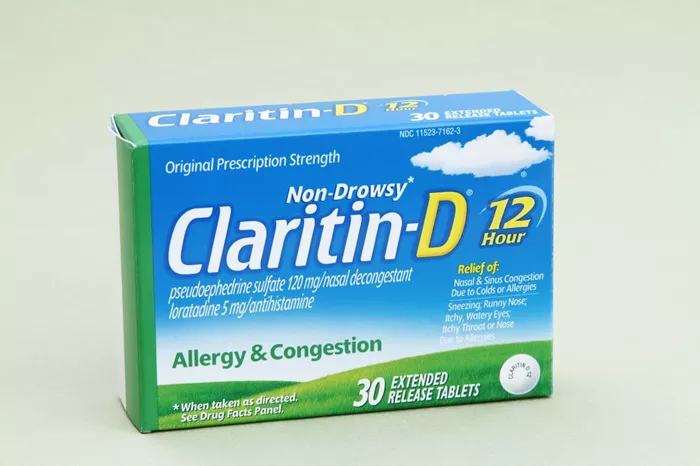Claritin-D, a popular over-the-counter medication, is commonly used to relieve symptoms of allergies and nasal congestion. However, some users report experiencing a sensation of feeling “high” after taking this medication. This article delves into the reasons behind this phenomenon, exploring the pharmacological components of Claritin-D, their effects on the body, and the potential implications for users.
What is Claritin-D?
Components of Claritin-D
Claritin-D is a combination medication that includes two active ingredients: loratadine and pseudoephedrine.
Loratadine: An antihistamine that helps reduce allergy symptoms such as sneezing, itching, and runny nose by blocking the action of histamine, a substance in the body that causes allergic symptoms.
Pseudoephedrine: A decongestant that works by shrinking the blood vessels in the nasal passages, which helps reduce nasal congestion.
Forms and Dosages
Claritin-D is available in various forms, including 12-hour and 24-hour extended-release tablets. The dosage and frequency of use depend on the specific product and the severity of the symptoms.
How Claritin-D Works
Mechanism of Loratadine
Loratadine, as an antihistamine, blocks the H1 histamine receptors in the body. By doing so, it prevents histamine from binding to these receptors, thereby reducing the symptoms of allergic reactions. Loratadine is known for being non-sedating, meaning it typically does not cause drowsiness, unlike some older antihistamines.
Mechanism of Pseudoephedrine
Pseudoephedrine is a sympathomimetic amine, which means it mimics the action of the sympathetic nervous system. It works by stimulating the release of norepinephrine, a neurotransmitter that causes the constriction of blood vessels in the nasal passages. This action helps reduce swelling and congestion.
Why Claritin-D Can Make You Feel High
Pseudoephedrine’s Stimulant Effects
The sensation of feeling “high” that some users report after taking Claritin-D is primarily due to the effects of pseudoephedrine. Pseudoephedrine is structurally similar to amphetamines, a class of stimulant drugs. This similarity allows pseudoephedrine to exert stimulant effects on the central nervous system (CNS), which can lead to feelings of euphoria, increased energy, and heightened alertness.
Release of Neurotransmitters
Pseudoephedrine stimulates the release of norepinephrine and, to a lesser extent, dopamine. These neurotransmitters play key roles in regulating mood, energy levels, and alertness. Elevated levels of these chemicals in the brain can produce a sense of well-being and exhilaration, which some people describe as feeling “high.”
Individual Sensitivity
People have varying sensitivity to medications based on factors such as genetics, body weight, and overall health. Some individuals may be more susceptible to the stimulant effects of pseudoephedrine, leading them to experience more pronounced feelings of euphoria or stimulation.
Interaction with Other Substances
The effects of pseudoephedrine can be amplified when taken with other stimulants, such as caffeine or certain medications for attention deficit hyperactivity disorder (ADHD). These interactions can enhance the stimulant properties of pseudoephedrine, increasing the likelihood of feeling “high.”
Potential Side Effects and Risks
Common Side Effects
While some users may experience a pleasant “high,” others may encounter less desirable side effects, including:
1. Increased heart rate
2. Elevated blood pressure
3. Anxiety or nervousness
4. Insomnia or difficulty sleeping
5. Dizziness or lightheadedness
Serious Side Effects
In rare cases, pseudoephedrine can cause more severe side effects, particularly when taken in high doses or by individuals with certain health conditions. These may include:
1. Heart palpitations
2. Severe hypertension (high blood pressure)
3. Arrhythmias (irregular heartbeats)
4. Seizures
5. Risk of Misuse and Abuse
Because of its stimulant properties, pseudoephedrine has the potential for misuse and abuse. It is a precursor in the illegal production of methamphetamine, a powerful and addictive stimulant. As a result, the sale and purchase of pseudoephedrine-containing products are regulated in many regions.
Who Should Avoid Claritin-D?
Individuals with Certain Health Conditions
Certain individuals should avoid taking Claritin-D or consult with a healthcare provider before use, especially those with:
1. Hypertension (high blood pressure)
2. Heart disease
3. Thyroid disorders
4. Diabetes
5. Glaucoma
6. Enlarged prostate
Pregnant or Breastfeeding Women
Pregnant or breastfeeding women should consult their healthcare provider before using Claritin-D to ensure it is safe for them and their baby.
Children and Adolescents
Claritin-D should be used with caution in children and adolescents. The dosage must be appropriate for the age and weight of the child, and parents should monitor for any adverse reactions.
Managing and Preventing Side Effects
Proper Dosage and Timing
To minimize the risk of experiencing a “high” or other side effects, it is essential to take Claritin-D exactly as directed. Do not exceed the recommended dosage or frequency.
Monitoring Interactions
Be aware of potential interactions with other medications, supplements, or substances. Inform your healthcare provider of all the products you are taking to avoid adverse interactions.
Healthy Lifestyle Choices
Adopting healthy lifestyle choices, such as maintaining a balanced diet, staying hydrated, and engaging in regular physical activity, can help mitigate some of the stimulant effects of pseudoephedrine.
Alternatives to Claritin-D
If you are sensitive to pseudoephedrine or experience adverse effects, consider discussing alternative treatments with your healthcare provider. Other medications or therapies may effectively manage your allergy and congestion symptoms without causing unwanted side effects.
Conclusion
Claritin-D is a widely used medication for relieving allergy symptoms and nasal congestion, thanks to its combination of loratadine and pseudoephedrine. While effective, the pseudoephedrine component can cause a sensation of feeling “high” in some users due to its stimulant effects on the central nervous system. Understanding the reasons behind this phenomenon, including the pharmacological actions and individual factors, can help users manage and mitigate these effects. Always consult with a healthcare provider before starting or changing any medication regimen, particularly if you have underlying health conditions or are taking other substances. By following proper usage guidelines and being mindful of potential side effects, you can safely benefit from the therapeutic effects of Claritin-D.
[inline_related_posts title=”You Might Be Interested In” title_align=”left” style=”list” number=”6″ align=”none” ids=”8882,8878,8810″ by=”categories” orderby=”rand” order=”DESC” hide_thumb=”no” thumb_right=”no” views=”no” date=”yes” grid_columns=”2″ post_type=”” tax=””]































